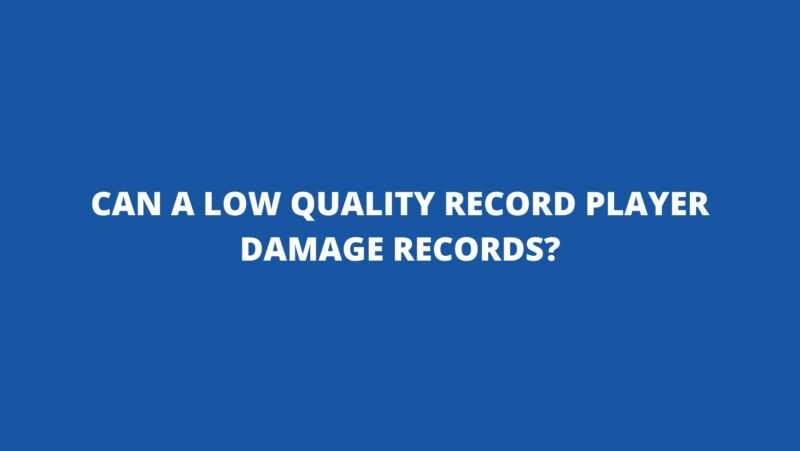The resurgence of vinyl records in the digital age has rekindled a fervent appreciation for the analog music experience. Vinyl enthusiasts relish the tactile engagement, the warm sonic textures, and the nostalgic allure of the format. However, as vinyl continues to captivate a new generation, questions about equipment quality and the potential risks it poses to cherished vinyl records emerge. One of the central queries is whether a low-quality record player can actually damage vinyl records. In this comprehensive article, we embark on a journey to uncover the intricate dynamics between low-quality record players and vinyl records, investigating potential risks, and offering insights into how to preserve your vinyl collection.
The Record Player-Vinyl Relationship: Delicate Balancing Act
Before delving into the potential impact of low-quality record players on vinyl records, it’s essential to grasp the intricate interplay between the two components of the analog playback equation. A record player serves as the conduit between the physical grooves etched into vinyl records and the audible music that emerges from the speakers. The stylus traverses the grooves, converting the mechanical movements into electrical signals, which are then amplified and broadcast as sound. This journey is delicate and intricate, relying on the precise interaction between the stylus, tonearm, platter, and other components of the record player.
Risks of Low-Quality Record Players
- Inferior Build and Components: Low-quality record players often compromise build quality and utilize subpar components to cut costs. These components can include lightweight and unstable platters, substandard tonearms, and poorly designed cartridges. These inadequacies can lead to uneven tracking and unnecessary wear on the grooves.
- Incorrect Tracking Force: Proper tracking force—the downward pressure exerted by the stylus on the grooves—is essential for optimal playback. Low-quality record players may lack proper calibration mechanisms for tracking force, leading to either excessive pressure that accelerates groove wear or insufficient pressure that affects playback quality.
- Lack of Isolation: Effective isolation mechanisms are critical for maintaining stable playback. Low-quality players may lack proper isolation, making them susceptible to vibrations from external sources. Vibrations introduce unwanted noise and can contribute to groove damage over time.
- Stylus and Cartridge Quality: The stylus and cartridge are pivotal for accurately reading the grooves and reproducing sound. Low-quality record players often come with substandard styluses and cartridges, which not only compromise sound quality but can also harm the delicate grooves due to improper alignment or excessive wear.
- Speed Inconsistencies: Maintaining consistent rotational speed (RPM) is vital for accurate playback. Low-quality players may exhibit speed fluctuations, affecting pitch accuracy and potentially causing groove damage due to stylus instability.
Mitigation and Preservation Strategies
- Invest Wisely: If budget constraints are present, invest time in researching entry-level record players from reputable manufacturers that prioritize build quality and performance. Look for turntables with stable components and positive user reviews.
- Proper Calibration: Regardless of the price point, accurate calibration is paramount. Ensure proper tracking force, anti-skate settings, and cartridge alignment according to the manufacturer’s specifications. A stylus force gauge can aid in precise calibration.
- Upgrade Potential: Consider record players with upgradeable components. This allows you to enhance performance and safeguard records without needing to invest in an entirely new setup.
- Isolation Solutions: Focus on providing proper isolation for your record player. Stable surfaces, isolation platforms, and minimizing external vibrations can significantly contribute to preserving groove integrity.
- Regular Maintenance: Regularly clean your record player and your vinyl records. Dust and debris exacerbate groove wear and sound distortion.
Conclusion
The potential for a low-quality record player to damage vinyl records is a concern that requires careful consideration. While it’s true that subpar components and inadequate design can lead to unnecessary wear and compromised sound quality, it’s also possible to mitigate these risks through informed decisions and proactive measures.
The revival of vinyl should remain accessible to enthusiasts of all budgets, but the preservation of the analog experience demands attention to quality and proper care. By researching, understanding the mechanics of record players, and embracing strategies that prioritize proper calibration, isolation, and maintenance, you can engage in the analog realm with confidence. In doing so, you ensure that your vinyl collection remains a harmonious haven for cherished melodies and the authentic sonic textures that make vinyl a cherished medium.


